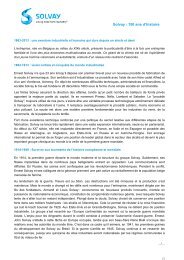solvay_live243_p02a04 somEdito
solvay_live243_p02a04 somEdito
solvay_live243_p02a04 somEdito
Create successful ePaper yourself
Turn your PDF publications into a flip-book with our unique Google optimized e-Paper software.
Dossier SolvayInnovationTrophy2006<br />
52<br />
Since 2000, Intel has been practising a radically new<br />
approach to exploratory research. Realizing<br />
that collaboration with universities is essential<br />
for exploration and that the issue of intellectual<br />
property rights was introducing tension into universitybusiness<br />
company relations, Intel had<br />
to come up with something new. Intel’s solution<br />
is to collaborate as peers by creating a small lab<br />
on or close to campus and allowing research freedom<br />
under a broad Intel-Research vision and agenda.<br />
A daring piece of folly? Whilst admitting an occasional<br />
hick-up inherent to the nature of the labs, Intel<br />
is continuing with this approach which creates a<br />
fantastic working atmosphere and generates much<br />
more interesting results.<br />
Intel is known across the world as the number one producer<br />
of integrated circuits and semiconductors. The little “Intel<br />
inside” sticker on your laptop tells you that it is fitted with an<br />
Intel processor - Pentium, Celeron, Xeon, Core or Dual Core.<br />
This is a very fast-moving market, in which manufacturers<br />
maintain leadership only by remaining at the sharp edge<br />
of technology.<br />
Intel was born in California in 1968, and grew rapidly under the<br />
leadership of Andrew S. Grove, Gordon E. Moore and Robert W.<br />
Noyce. In 1991, with the advent of personal computers (PCs)<br />
based on x86 processors, Intel climbed to first place among electronic<br />
chip manufacturers. It is still there, employing 100 000<br />
people worldwide, with 11 production units and six dedicated<br />
assembly and testing facilities. The one European production<br />
unit is at Dublin, in Ireland.<br />
Innovation at the heart of the corporate mission<br />
Innovation is a central concept in Intel’s mission. Intel employs<br />
around 7 000 people in R&D. Technology Director Justin Rattler<br />
directs the R&D strategy. In inter-networked laboratories across<br />
the world, his teams are working hard on short and medium-term<br />
operational development projects in close liaison with the various<br />
parts of the business. Intel also has a technology marketing<br />
centre. Finally, six years ago Intel launched an exploratory research<br />
department with a radically new angle. Intel has developed its<br />
OCR (Open and Collaborative Research) model to reduce<br />
Intel laboratory at Cambridge University (England).<br />
Intel: researching in a<br />
of openness and coo<br />
conflicts around intellectual property, a legal concept that acts as<br />
a brake on cooperation between industries and universities. “We<br />
want our researchers not to be worrying about intellectual rights”,<br />
explains Intel Research Associate Director Hans Mulder. “This<br />
approach has enabled us to attract the most brilliant brains and to<br />
allow them to really develop their ideas. In our university laboratories<br />
you won’t see a researcher whispering to another scientist in a<br />
corridor and then shutting up when a student passes within earshot!”<br />
Intel has set up four university-linked laboratories: three in the<br />
United States (Berkeley, Pittsburgh and Seattle) and one in Europe<br />
(Cambridge). The reason is clear: world-class universities, very<br />
smart people, collaborative in nature, and because of their excellence,<br />
places where good ideas from other universities pass through<br />
by means of visitors, new faculty, presentations, etc. Located in the<br />
immediate proximity of university campuses, these small laboratories<br />
are staffed by 12-18 researchers, but have space for 40 to<br />
50. This allows them to take in university students and interns<br />
who provide key brainpower for particular projects. These laboratories<br />
are directed (except at Cambridge) by a university professor<br />
employed by Intel to develop a specific project. Intel offers this<br />
professor a laboratory, a team and space for students. The result<br />
is an effective research tool, with both equipment and brainpower.<br />
The quality of the professor and his or her commitment to<br />
successfully carrying through the project are obviously decisive


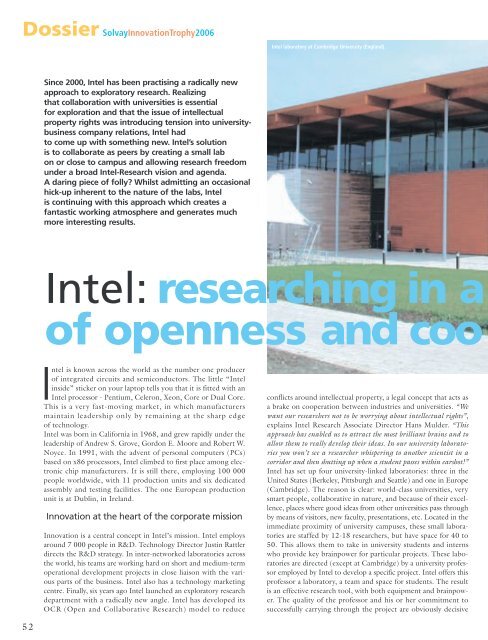

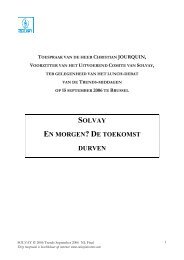
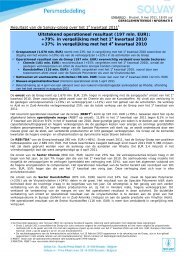

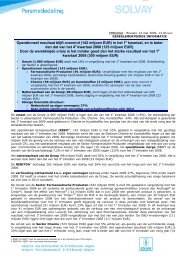


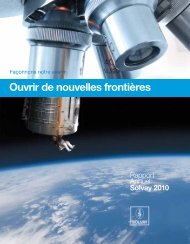
![PROC.1 [LETTRE] - Solvay](https://img.yumpu.com/16585746/1/184x260/proc1-lettre-solvay.jpg?quality=85)
